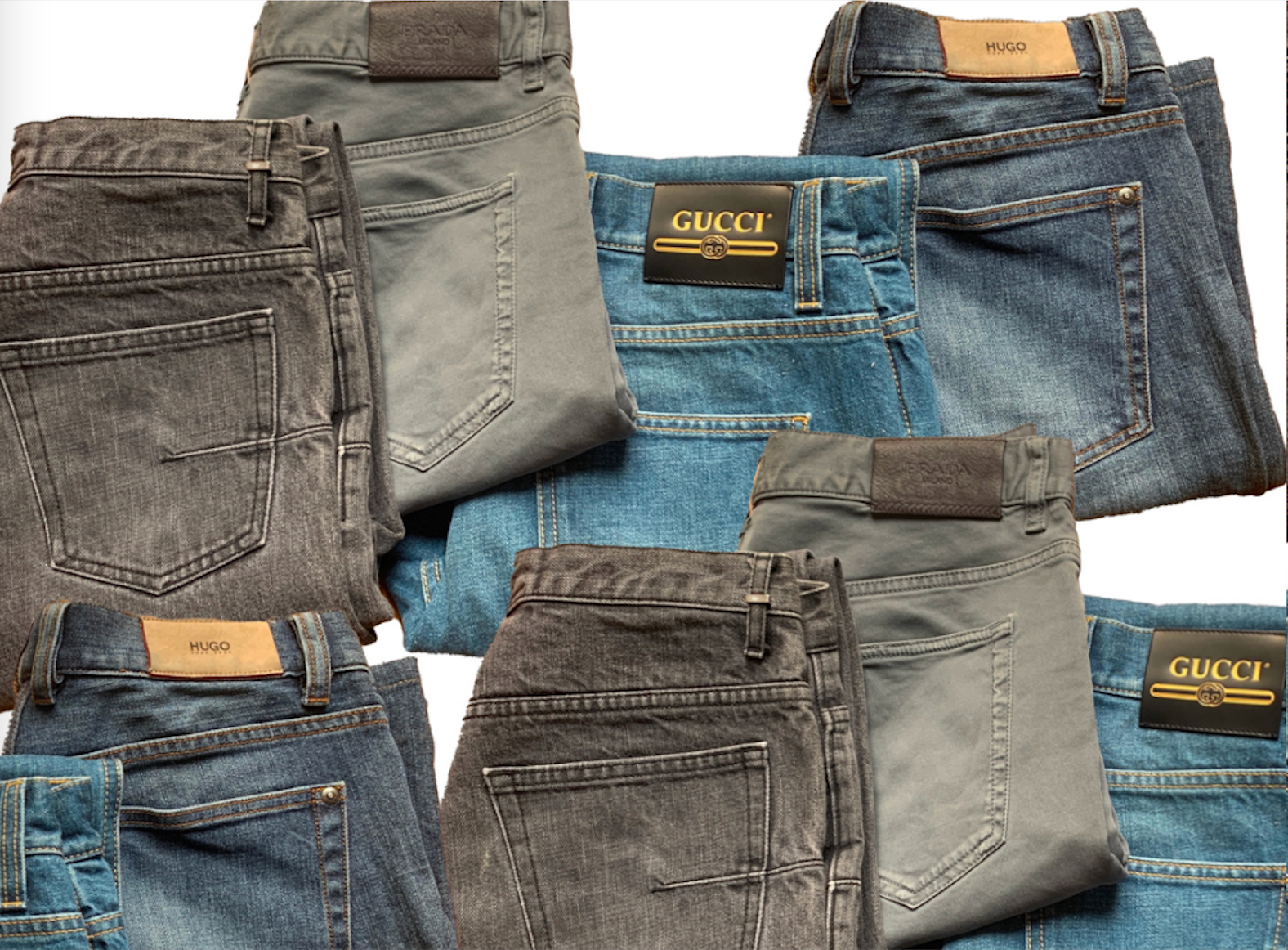Timeless but subject to fashion, durable but the most polluting product of the second most polluting industry in the world, a symbol of youth but adopted from 0 to 90 years old... in terms of textiles, is there a more paradoxical item than jeans, whether for the place they occupy in the hearts and wardrobes of men or in terms of carbon footprint?
To simplify the reading and choice of this garment that, statistically, you have a 99% chance of having in your closet, Beau Gustave has prepared some points of reference for you. History, selection criteria, and the diversity of cuts will be discussed.
You will also quickly understand why choosing your second-hand denim is particularly relevant and virtuous.
Check out our collection of jeans and denim jackets!
Versatile but sexy (how to choose the right jeans)
In the otherwise merciful eyes of the Handsome Gustave, jeans that hang loose over a buttock that is inevitably flabby due to the lack of support are one of the worst sins of style.
When getting dressed, looking at your back is always a good idea, but while we can forgive a slightly short jacket, a slightly tight torso, or slightly short pants, loose jeans are unforgivable. And why not a Decathlon backpack or a Kway fanny pack?
At the heart of the Jean , there is the buttock.
Of course, it's not so easy to get it right. Firstly, because jeans always stretch a little.
So it should be a little tight when you try it on. If you slip a finger between your body and the jeans , they are too big. The same goes if you need a belt to hold them up. On the other hand, after half a day, you should be able to bend your knees without difficulty.
The points to check the suitability of the jeans to your person also include the thigh, which must be molded, the folds of the fly must go straight outwards without tending to ride up, and finally the pocket, which must be difficult to access.
Regarding the length: it's up to you. But if you're unsure, you can't go wrong by choosing the length that "breaks" the shoe.
As for the hem, or rather the way you choose to finish your trousers, there too, it's up to you: according to the rules of an ordinary hem, rolled up, frayed (perhaps the least durable)
For those who are reassured by the figures, here are two additional indications:
About the size. There are two types of size: French and American.
Always practical, Americans specify two measurements: the waist ("W") and the length ("L"). There is a difference of 8 to 10 digits between the American size and the French size. For example, a French 38 will be an American 28 or 30.
As for the length, it specifies the inseam, under the fly: Length 30 is equal to 76.20 cm, 32 is equal to 81.30 cm, 34 is equal to 86.40 cm, 36 is equal to 91.50 cm. Everything also becomes clear when we remember that an inch is worth 2.54 cm….
Now you're ready to try on your jeans . And you've learned that a pair of jeans that has lost its first primer thanks to a previous owner who did the work for you is an additional assurance of choosing the right one. Ultimately, jeans are a bit like the English gentleman's wardrobe: better when the butler has worn them a bit. Sometimes LBG sells new jeans second-hand , but here, we're doing everything we can to help you.
The right cut
Fashion marketing is quite creative when it comes to fit, but these elements should normally get you started.
A must-have! While it's more flattering for tall, slimmer figures, it ultimately suits just about any body shape, whether it's slimming or flattering. You can find slim-fit jeans with a low, medium, or fitted waist, but the thigh is always flattering and it's always fitted at the ankle.
Pay particular attention to the size; we recommend a high waist for those with a small, rounded belly, as this will give a slim fit a new lease of life to a greedy forty-year-old. This advice will not be repeated, but applies regardless of the cut.
It's very easy to look stylish with slim-fit jeans: they'll show off your sneakers, loafers or ankle boots, they'll go well with straight or fitted shirts, and they'll look great with a city jacket like a leather jacket or a bomber jacket under a sweater.
The straight cut (or “regular”)
As the name suggests, it's straight from the waist to the ankle, just a little slimmer at the knees! Here too, it remains quite open in terms of silhouette, but you still need to fill out the thigh, one of the 3 points for checking the right fit for jeans.
It is available in medium, low, or fitted sizes.
If we had to show the ecumenical character of this cut, we would say that the mythical 501 of Levis - date of birth 1890 - is a “regular” cut,

The “straight” (or “semi-slim”) cut
It's on the border between slim and straight. To the point that one brand will classify a pair of jeans as regular while another would have classified them as straight. Either way, at some point, the fitting will tell you.
The bootcut cut.
Straight to the knees – or even a little tight, the cut widens below.
It allows you to wear slightly more substantial shoes. For example, boots! These are perfect jeans for tall people, but also suitable for slightly shorter legs. The Levis 527 is a "bootcut." Less suitable for office days, this cut, however, looks equally good with a jacket or a blazer.
 Example of a Gucci bootcut jean
Example of a Gucci bootcut jean
Tapered jeans
The thigh is quite wide, the pants taper down towards the foot.
A modern cut, it's the Levi's 512. Sometimes more attractive on the hanger than on the body, it can also carry your silhouette with style and renewal. She loves barefoot loafers or lace-up ankle boots.
The cuts tour could include the skinny – a very fitted version of the slim – and we could comment on other versions, but it seems to us that at this stage, you have enough to do your research.
Variation on the canvas
Color and wash are ways to personalize your jeans.
Stonewashing was discovered by chance in the 1970s by Marithé and François Girbaud, fashion stars of the time. Wanting to soften the overly stiff fabric of their raw denim, they came up with the idea of running it through a machine with pumice stones, which rubbed the fabric without damaging it. The result: a softer fabric but without any damage. Stonewashing was born.
Today, it remains a technique, but let's remember that ozone and laser treatment – which save water – are gaining ground, while sandblasting is tending to disappear. And that's a good thing because, in ecological and human terms, it was clearly not a virtuous idea.
A final word on Selvedge
Very popular because it is synonymous – not necessarily rightly – with superior quality, the word
Selvedge is a contraction of the English word “ Self Edge ”, short for “Self-finished edge” .
Simply put, it's a uniform finish on the fabric at its ends to prevent fraying. It is therefore reinforced and often forms a colored border. By using a single weft thread, the weave is tighter and more resistant. On the other hand, the production time and fabric yardage are much higher.
Do not confuse selvedge with raw: raw is a twill fabric soaked in indigo whose color has not been subsequently treated. Selvedge is a manufacturing method: you can find raw selvedge and raw non-selvedge, non-raw selvedge and also raw.
Selvedge is the historical channel for denim—in the USA in the 1880s. But as demand exploded, the industry opted for lower-yield machines. It was via Japan, in the 1980s, that selvedge returned, a criterion of quality. The red piping that finishes the fabric comes from the fact that this was how Levis signed its fabrics, when the Japanese imported to imitate them.
While it is not an absolute guarantee of qualitative superiority, and you can find magnificent non-selvedge fabrics and selvedge fabrics that do not justify their price, undoubtedly, after a few slightly "stiff" wears, selvedge fabrics are perfectly comfortable. And they will patinate very nicely.
Example of Selvedge jeans with a model from R Ralph Lauren
Don't hesitate to come and continue the dialogue, in the showroom as well as on the Internet @lebeaugustave , as this piece is both essential in a man's wardrobe and relevant second-hand.
You can find our jeans collection on our website by clicking here !
Thanks to…. There are plenty of articles on jeans, but our main sources were The Goodgoods, La Redoute, the blog "commeuncamion," Asphalte, and Les Inrockuptibles. Thanks to them for everything we've learned, more or less, and we're very happy to share it.
Photo source ( https://designmag.fr/mode/jean-a-la-mode-1800-1984-476004.html ; https://www.numero.com/fr/mode-homme/selection-homme-denim-jean-automne-hiver-2020-2021-valentino-paul-smith-tom-ford-telfar-ferragamo-yproject#slide123425 )




